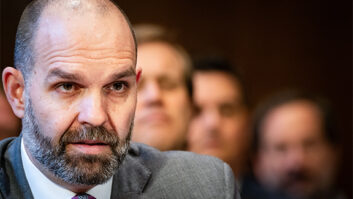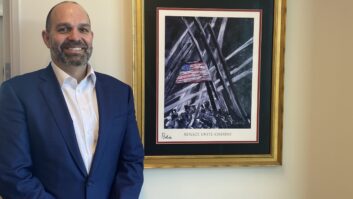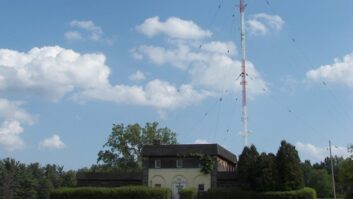Serving the Local interest
Dec 1, 2003 12:00 PM, By John Battison, technical editor, RF
When the LPFM application window opened in Ohio, an opportunity was nearly missed.
The matter had been discussed among the churches but at first no one expressed enough interest to proceed.
Loudonville is the second-largest city in the County of Ashland with a population of about 2,800 people. This community lies at about the midpoint between Columbus and Cleveland, near Mansfield. There is an FM station licensed to Loudonville, however, it has no presence in town, only an 800-number to call. Its studio is in Mount Vernon, which is about 20 miles away. A radio station that would truly serve the town was needed.
The pastor of the Zion Lutheran Church, Reverand Terry Ruther, was approached with the suggestion that his church apply for a construction permit for a low-power FM station. The goal would be for the station to serve his church, the city and local area. A basic initial plan was developed and he applied for a construction permit. The plan called for an antenna to be mounted on a pole on the church spire and to locate the transmitter and studio in a church office, thus keeping costs low and placing everything close together.
Photo by Jim Brewer, Loudonville Times

Looking into the control room of WZLP.

The talk studio can accommodate as many as three guests.

The studios are compact, but they are functional.

The construction permit was duly issued and all seemed well until someone noticed that the CP showed an effective radiated power (ERP) of 1W. The FCC Form 318 was electronically filed by a volunteer, but the height above ground in the filing was incorrectly entered as 290m instead of 29m. A quick modification led to a new CP with the desired 100W ERP.
During the time that elapsed between the application and the grant of the CP, the church congregation’s interest grew and ambitious plans began to make this truly a local station. Construction, programming, operation, financing and staffing committees were formed. Meetings were held with the school superintendent, the director of the public library and the city officials, all with the objective of including these sources in the station’s programming. As a result of all this pre-programming activity, it was decided that effort should go for broke and take the time to find the best available transmitter site. After finding a better site, the CP was modified and WZLP was on its way to getting on the air.
Selecting the equipment
Time passed quickly, and the 18 months allowed for construction had elapsed to leave about six months remaining. The church was fortunate to have several members who had some broadcast experience and who took over the problems of obtaining equipment and installing the station. A budget of $50,000 was envisioned, and a retired former Christian station program director was hired to oversee construction. Once again, good fortune stepped in and contact with a nearby Christian station resulted in the purchase of a 100′ self-supporting tower for $5,000. The price included removal, transportation and the erection of the antenna, transmission line and tower at the site, which was not an easy job because of the local terrain.
Considerable site work was required in bulldozing and clearing the site and a path to it. All power and telephone lines were buried. An 8′ � 10′ cinderblock building was constructed on a concrete slab and a 10′ security fence erected around the building and the tower. The area is fairly remote and vandalism is not unknown in Loudonville. A C-band dish was also installed with its output feeding a switcher inside the transmitter building. Satellite programming switching is remotely controlled from the studio and is fed directly into the transmitter input.
Inside the building, a Crown 100W transmitter operating at 112W output (the transmitter is rated at 120W, and the church insisted it meant that 112W continuous will work) drives a Shively two-bay 6812 antenna.
A little knowledge is a dangerous thing, and it was necessary to explain to the eager beaver church member �engineers� that an STL was not the same as an RPU, and could not be used for remote pickup at football games. This having been explained many times, a stereo loop was ordered from the telephone company together with two regular phone lines for remote control and communication. Fortunately, an incredibly low rate was available for the telephone services, making the STL option moot.
WZLP’s first remote broadcast was an away football game less than six weeks after going on the air. A simple installation using a Conex Flip Jack 2 was used via a POTS line. As far as is known this was the first local live remote broadcast of a Loudonville high school football game, although a local commercial station has been in existence for 10 years.
The basic, simple, low-power FM installation plan that was originally envisioned had long since been discarded. The congregation’s excitement and acceptance of the proposed station produced a surprising amount of donations and grants. By now more than $50,000 was available for construction. This meant that new equipment, in most cases, could be purchased and although many offers of used equipment had been received comparatively little was actually used. But heartfelt thanks were offered to the generous potential donors.
Inside the studios
The studio is located across the road and in a house that is owned by the church. This building is used as an annex and contains conference rooms and young people’s recreational rooms as well as a counseling service. The area allocated to the studio is about 12’�12′ and it was recommended that this be used as a combination control room and studio. This would provide adequate space for several program participants plus the operator and studio equipment and makes for comfortable talk shows. A production studio was planned for the future and there is ample room in the building.
However, the experienced members of the committee wanted a real radio studio, with a separate control room and studio. The result is a small control room and a small studio. Adequate soundproofing was installed; air-conditioning is provided by a window unit that is turned off when necessary.
The studio layout is convenient, although it will probably be changed as time passes and more equipment is added. Suitable switching has been installed to allow the console and master control to be used as a production studio while a live studio program is on the air.
The church did not skimp on studio equipment and computerized operation and logging is used. All the live programming at present originates in the studio and consists of talk monologs and discussions. Plans are in place to run a line across the road to the church for live religious service broadcasts and chats from the pastor’s office. When this is completed, live church services will be carried regularly. Services from other churches will be carried by means of phone lines. The Loudonville school also provides several local live programs, and school information notices are carried daily through this connection.
The station started its operations the right way. It is an LPFM station, but it is a real radio facility with the kind of operations and programming that used to be found in good commercial radio stations. In the end, construction costs to pass the states’ many nitpicking inspections cost almost as much as the radio equipment. Signal coverage is in line with the Commission’s anticipated level, and is usable at more than 10 miles in some directions and covers the adjoining village of Perrysville, which is what the church wanted.
Equipment list
Andrew coaxial cable
Broadcast Tools SS8.2 switchers
BSI Simian automation
Conex Flip Jack 2 and single Flip Jack
Crown FM100 transmitter
Electro-Voice 635A microphones
Inovonics 530 modulation monitor
Mackie model SR24�4 console
Marantz PMD320 CD player
O.C. White microphone booms
Shively 6812 antenna
Tascam 302 cassette
TFT EAS 911
Wegener Unity 4000 satellite receiver







